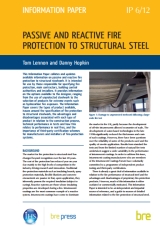Passive and reactive fire protection to structural steel (IP 6 12)
BRE (Building Research Establishment) is an independent, research-based consultancy, testing and training organisation, operating in the built environment and associated industries.
Passive and reactive fire protection to structural steel (IP 6/12) was written by Tom Lennon and Danny Hopkin and published by BRE on 19 January 2012.
Traditional fire-protection materials such as insulating boards, spray protection materials, flexible blankets and concrete encasements are passive in that, upon application, they inherently possess the required insulation. Reactive systems are those whose insulating properties are developed during a fire. Intumescent coatings are the most common example of reactive systems.
This 8-page information paper collates the available information on passive and reactive fire protection to structural steelwork. It covers:
- The types of product available.
- Specification.
- The advantages and disadvantages of different types of product in relation to the construction process, technical performance in tests and performance in real fires.
- The importance of third-party certification schemes for manufacturers and installers.
It is intended for use by those responsible for specifying fire protection, main contractors, building control authorities and installers, and provides information on the options available for designers, ranging from the use of unprotected steelwork to the selection of products for extreme events such as hydrocarbon fire exposure.
Its contents are:
- Background.
- Introduction.
- Unprotected steel structures.
- Partially encased steel sections.
- Protected steel sections.
- Application and third-party certification schemes.
- Fire testing and assessment.
- Performance in real fires.
- Sources of further information.
- References.
- Further reading
[edit] Related articles on Designing Buildings
- Approved document B.
- BRE articles on Designing Buildings Wiki.
- BRE Buzz articles on Designing Buildings Wiki.
- BRE Buzz.
- Building Research Establishment.
- Fire in buildings.
- Fire protection engineering.
- Fire.
- Installing fire protection to structural steelwork (GG 85).#
- Intumescent coatings.
- Passive fire protection is a vital tool in any fire strategy.
- Steel.
Featured articles and news
RTPI leader to become new CIOB Chief Executive Officer
Dr Victoria Hills MRTPI, FICE to take over after Caroline Gumble’s departure.
Social and affordable housing, a long term plan for delivery
The “Delivering a Decade of Renewal for Social and Affordable Housing” strategy sets out future path.
A change to adoptive architecture
Effects of global weather warming on architectural detailing, material choice and human interaction.
The proposed publicly owned and backed subsidiary of Homes England, to facilitate new homes.
How big is the problem and what can we do to mitigate the effects?
Overheating guidance and tools for building designers
A number of cool guides to help with the heat.
The UK's Modern Industrial Strategy: A 10 year plan
Previous consultation criticism, current key elements and general support with some persisting reservations.
Building Safety Regulator reforms
New roles, new staff and a new fast track service pave the way for a single construction regulator.
Architectural Technologist CPDs and Communications
CIAT CPD… and how you can do it!
Cooling centres and cool spaces
Managing extreme heat in cities by directing the public to places for heat stress relief and water sources.
Winter gardens: A brief history and warm variations
Extending the season with glass in different forms and terms.
Restoring Great Yarmouth's Winter Gardens
Transforming one of the least sustainable constructions imaginable.
Construction Skills Mission Board launch sector drive
Newly formed government and industry collaboration set strategy for recruiting an additional 100,000 construction workers a year.
New Architects Code comes into effect in September 2025
ARB Architects Code of Conduct and Practice available with ongoing consultation regarding guidance.
Welsh Skills Body (Medr) launches ambitious plan
The new skills body brings together funding and regulation of tertiary education and research for the devolved nation.
Paul Gandy FCIOB announced as next CIOB President
Former Tilbury Douglas CEO takes helm.
UK Infrastructure: A 10 Year Strategy. In brief with reactions
With the National Infrastructure and Service Transformation Authority (NISTA).
























